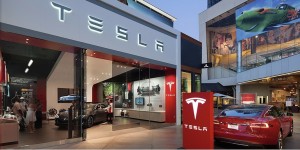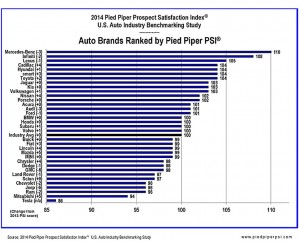
Despite claiming it can do a better job of helping customers than franchised dealers, Tesla came in last in the latest Pied Piper Prospect Satisfaction Index.
For many – perhaps most – motorists, buying a car is a process only slightly less painful than having a root canal. Yet some dealers do a markedly better job not only keeping potential customers satisfied but also making sure they close the deal. Who’s doing the best job is the subject of a new study that puts Mercedes-Benz at the top of the list, and battery-car start-up Tesla way down at the bottom.
It’s the first time Tesla has been included in the annual Pied Piper Prospect Satisfaction Index, and it raises serious questions about the California carmaker’s claims to be doing things a better way with an approach that relies on factory-owned, rather than franchised, showrooms.
“Today, car salespersons have become a lot more helpful” than they were barely a decade ago, said Fran O’Hagan, the analyst behind the Pied Piper study. But he cautions that it takes more than just a friendly attitude and the ability to answer a customer’s questions to close a deal while also keeping buyers happy.
“We’re measuring how effectively a dealer turns a car shopper into a car buyer,” added O’Hagan.
The 2014 Pied Piper Satisfaction Index, or PPSI, looks in detail at the sales process, tracking how retailers and their sales staff follow what might be described as best practices. Do they greet a customer walking into the showroom? Do they outline specific and relevant features of a vehicle and compare it to the competition? Do they take the appropriate steps to close a sale rather than stand back as a potential buyer leaves the showroom?
By and large, the answer is yes at Mercedes-Benz stores, the German brand leading the PPSI as it has consistently over recent years – reflecting a concerted corporate effort to develop a best-practices approach to sales that O’Hagan says most Mercedes dealers now follow. Infiniti comes in a close second, followed by Lexus and, in a four-way tie, Cadillac, Hyundai, Smart and Toyota.
In general, there have been major – and generally positive – changes in the way dealers operate since O’Hagan launched the Pied Piper study in 2007. On the whole, it echoes the results of other studies that have found car shopping has become a bit less of a tedious chore. There’s less of what O’Hagan calls the “Wild West” practices that created a layer of anxiety for shoppers.
(Lexus the latest to go turbo with new NX. For more, Click Here.)
But while today’s salespeople tend to be more professional, some, he says, “fall into what I call the museum curator category. They answer your questions but they don’t proactively help turn you into a car buyer.”
Surprisingly, a majority of those working at Tesla showrooms “fell into that category,” O’Hagan’s team of mystery shoppers discovered after visiting every single one of the maker’s stores around the U.S. Where benchmark Mercedes scored 110 on the PPSI scale, with an industry-average score of 100, Tesla slumped to the bottom, at just 86.
(Click Here for details on rising gasoline prices in the U.S.)
Tesla salespeople, said O’Hagan, “are far less likely to give reasons to buy or offer a test drive or talk about financing options. They’re much more likely to fall into the museum curator category. They’re friendly and knowledgeable, but don’t do anything proactively to turn a shopper into a Tesla owner.”
The low score is all the more surprising considering the start-up maker’s argument that it can do a better job by owning its own stores rather than going the traditional franchise route – a position that has run it afoul of dealer groups and franchise laws in a number of states.
While dealers are generally doing a better job working with customers on the showroom floor, the latest Pied Piper study did find the old Wild West mentality remains, ironically, when it comes to working with customers online. Among other things, dealers often tend to be slow to respond to email requests from customers, a delay that can send a potential buyer scurrying to another store.
(To see more about GM and Ford enjoying record sales in China, Click Here.)
Lexus topped the industry in terms of Internet practices, said O’Hagan, though he quickly added that, “Even the top brands were only average at best.”
Asked why it matters to follow best-practice policies, O’Hagan said there is a direct correlation between those stores that top the PPSI chart and those at the bottom. The best dealers continuously outsell the poorer stores by 16%. For a manufacturer, that can translate into significant lost sales and market share and translate into higher incentives and advertising expenses.


There are three main reasons for Tesla’s low conversion rate:
1) They ARE museum styled tourist/visitor destinations designed to build brand.
2) They’re in high-traffic non-auto retail locations, so attract people not shopping for a car, but brand seeds are planted
3) They’re one model is in the rare field luxury sport category
In a few short years, their closing rates will change drastically with three models ranging from $30K to $100K
“the voice of the automotive world”? Srsly? It has become so very painfully obvious that Tesla is kicking the collective posteriors of its competitors, and they don’t even advertise. Selling every unit they make with a waiting list months long. Voted best car ever made. Highest point total by Consumer Reports. Best crash safety rating. If you guys are “the voice of the automotive world”, you sound like frkin Glenn Beck crying like a frightened little girl. Grow a pair!
Huh? Robert, we cover Tesla extensively, and just as we cover the rest of the industry, in depth and with a necessary mix of enthusiasm and skepticism. If we fawned over them – or any other brand – we’d need to grow a pair.
As for your claims, yes, Tesla has been highly reviewed. And it has been trashed. The mainstream non-automotive media puts the maker on a roller-coaster, hailing it one minute then running breathless headlines when there’s a problem. We prefer to maintain a more even tone. Now, no question the Model S has received some raves from the automotive community. But let’s see what happens with its second and third products v just one halo launch model. And no, they might not advertise but they shouldn’t need to. Because of the breakthrough nature of what they offer — AND the limited volumes of the Model S – they have been able to focus on careful and creative alternative marketing. Elon Musk’s blogging push has helped connect with a very tight and select audience. Whether its strategy can play out when it is trying to market 15,000 vehicles a month v 1,500, and starts to play in more mainstream segments, is an entirely different matter, and frankly, if they don’t change their showroom approach they will likely have some problems.
FYI, they may be selling all they can at a time when they simply don’t have much production, but that is largely irrelevant for the long-term. Indeed, the brand’s poor showing to date in Europe should be considered when analyzing Tesla’s longer-term potential. So should China. The initial reception there has been positive (as it was in Europe), but we are simply not far enough along to see how the big market there will respond.
Bottom line, Tesla has some clear momentum going for it but the story is far from written.
And you should learn that personal enthusiasm and balanced reportage are two different matters entirely. The latter requires a bit more, ahem, cojones.
Paul A. Eisenstein
Publisher, TheDetroitBureau.com